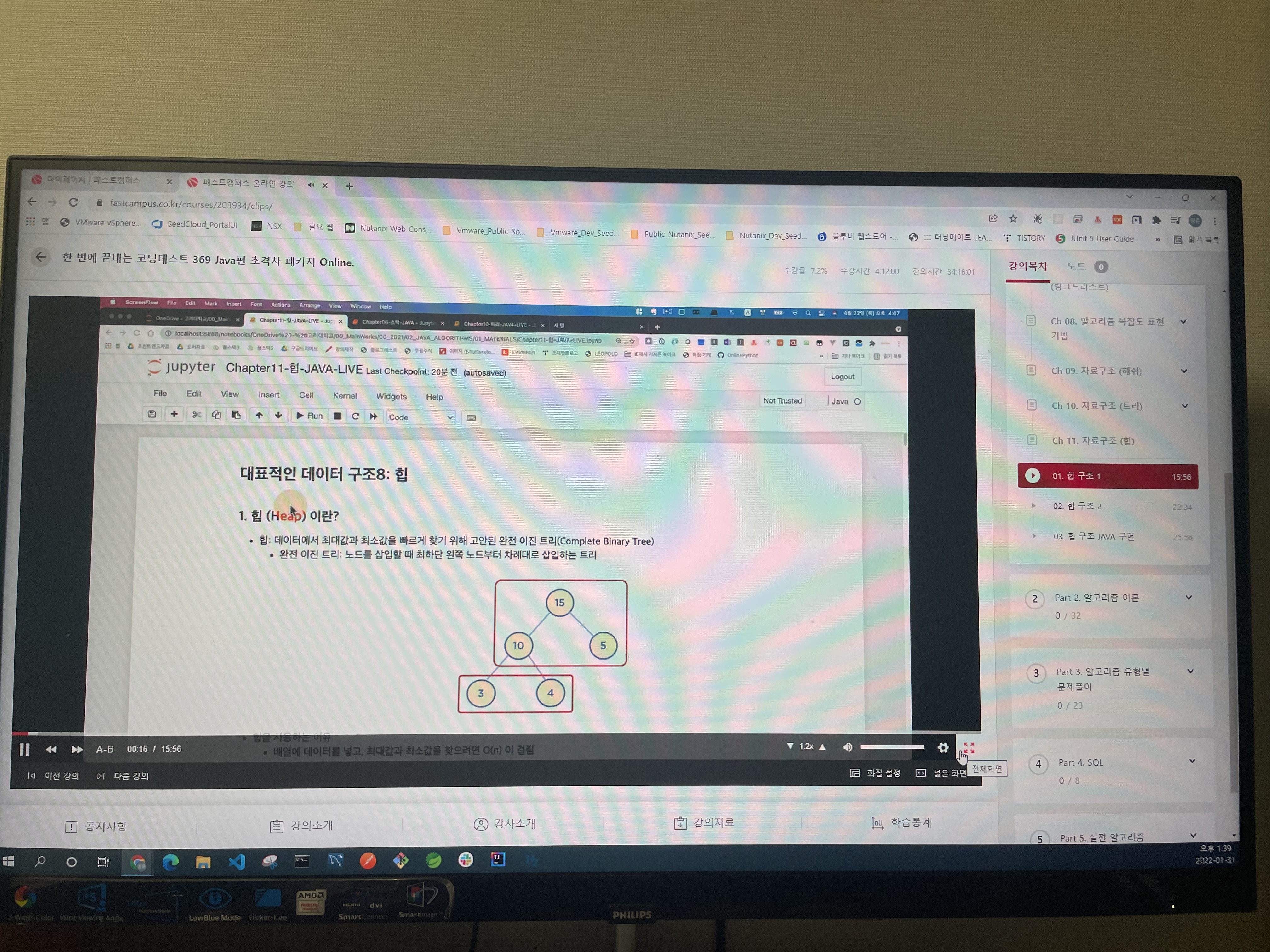데이터 구조 : 힙(Heap)
1. 힙(Heap) 이란?
- 데이터에서 최대값과 최소값을 빠르게 찾기 위해 고안된 완전 이진 트리
• 완전 이진 트리 (Complete Binary Tree)
- 노드를 삽입할 떄 최하단 왼쪽 노드부터 차례대로 삽입하는 트리
2. 힙을 사용하는 이유
- 배열에 데이터를 넣고, 최대값과 최소값을 찾으려면 O(n)이 걸린다.
=> 힙에 데이터를 넣고, 최대값과 최소값을 찾으면 O(logn)이 걸린다.
- 최대값 또는 최소값을 빠르게 찾아야하는 자료구조 및 알고리즘 구현 등에 활용
• 힙과 이진트리의 공통점
- 모두 이진 트리 이다
• 차이점
- 힙은 데이터 삽입 시 무조건 왼쪽에서 부터 데이터를 넣어, 왼쪽 및 오른쪽 자식의 노드 값은 어느것이 큰지 모른다.
- 이진 탐색 트리는 검색(탐색)을 위한 구조, 힙은 최대/최소 값을 검색을 위한 구조
3. 데이터 삽입
- 데이터 삽입 시 무조건 왼쪽부터 채우며 완전 이진트리를 만족하며 노드를 채운다.
- 추가된 노드의 데이터가 부모 노드의 데이터보다 클 경우 부모노드와 자식노드의 위치를 바꾸며 (swap) 이진트리를
만족시키며 트리를 완성한다.
4. 데이터 삭제
- 데이터 삭제 시에는 root 노드를 삭제한 후 가장 마지막 데이터를 root노드에 올린 후 swap 과정을 통하여
완전 이진트리의 형태로 만든다
힙 구현
• 힙과 배열
- 일반적으로 힙 구현시 배열 자료구조를 활용
- 배열은 인덱스가 0부터 시작하지만, 힙 구현의 편의를 위해, root 인덱스 번호를 1로 지정하면 구현이 수월
• 부모노드 인덱스 번호 = 자식 노드 인덱스번호 / 2 의 몫
EX) child index = 5 => 5 / 2 => 2.5 몫 2 = parent index
• 왼쪽 자식 노드 인덱스 번호 = 부모 노드 인덱스 번호 * 2
• 오른쪽 자식 노드 인덱스 번호 = 부모 노드 인덱스 번호 * 2 + 1

힙 클래스 구현
import java.util.ArrayList;
public class Heap{
public ArrayList<Integer> heapArray = null;
public Heap(Integer data){
heapArray = new ArrayList<Integer>();
heapArray.add(null); // 0번 index을 null로 바꿈
heapArray.add(data);
}
public boolean insert(Integer data){
Integer inserted_idx,parent_idx;
if(heapArray == null){
heapArray = new ArrayList<Integer>();
heapArray.add(null);
heapArray.add(data);
return true;
}
this.heapArray.add(data);
inserted_idx = this.heapArray.size() - 1; // 배열의 맨 마지막 인덱스
// 데이터 Swap
while(this.moveup(inserted_idx)){
parent_idx = inserted_idx / 2;
Collections.swap(this.heapArray,inserted_idx,parent_idx);
inserted_idx = parent_idx;
}
return true;
}
private booelan move_up(Integer inserted_idx){
if(inserted_idx <= 1){ // root 노드
return false;
}
Integer parent_idx = inserted_idx / 2;
if(this.heapArray.get(inserted_idx) > this.heapArray.get(parent_idx)){
return true;
}else{
return false;
}
}
// 데이터 삭제
public Integer pop() {
Integer returned_data, popped_idx, left_child_popped_idx, right_child_popped_idx;
if(this.heapArray == null) {
return null;
}else {
returned_data = this.heapArray.get(1);
this.heapArray.set(1, this.heapArray.get(this.heapArray.size() - 1));
this.heapArray.remove(this.heapArray.size() - 1);
popped_idx = 1;
while (this.move_down(popped_idx)) {
left_child_popped_idx = popped_idx * 2;
right_child_popped_idx = popped_idx * 2 + 1;
// CASE2: 오른쪽 자식 노드만 없을 때
if (right_child_popped_idx >= this.heapArray.size()) {
if (this.heapArray.get(popped_idx) < this.heapArray.get(left_child_popped_idx)) {
Collections.swap(this.heapArray, popped_idx, left_child_popped_idx);
popped_idx = left_child_popped_idx;
}
// CASE3: 왼쪽/오른쪽 자식 노드가 모두 있을 때
} else {
if (this.heapArray.get(left_child_popped_idx) > this.heapArray.get(right_child_popped_idx)) {
if (this.heapArray.get(popped_idx) < this.heapArray.get(left_child_popped_idx)) {
Collections.swap(this.heapArray, popped_idx, left_child_popped_idx);
popped_idx = left_child_popped_idx;
}
} else {
if (this.heapArray.get(popped_idx) < this.heapArray.get(right_child_popped_idx)) {
Collections.swap(this.heapArray, popped_idx, right_child_popped_idx);
popped_idx = right_child_popped_idx;
}
}
}
}
return returned_data;
}
}
public boolean move_down(Integer popped_idx){
Integer left_child_popped_idx,right_child_popped_idx;
left_child_popped_idx = popped_idx * 2;
right_child_popped_idx = popped_idx * 2 + 1;
// case 1 : 자식 노드가 하나도 없을 떄
if(left_child_popped_idx >= this.heapArray.size()){
return false;
}else if(right_child_popped_idx >= this.heapArray.size()){ // case 2 : 으론쪽 자식 노드만 없을 때
if(this.heapArray.get(popped_idx) < this.heapArray.get(left_child_popped_idx)){
return true
}else{
return false;
}
}else { // CASE3: 왼쪽/오른쪽 자식 노드가 모두 있을 때
if(this.heapArray.get(left_child_popped_idx) > this.heapArray.get(right_child_popped_idx)) {
if(this.heapArray.get(popped_idx) < this.heapArray.get(left_child_popped_idx)) {
return true;
} else {
return false;
}
} else {
if(this.heapArray.get(popped_idx) < this.heapArray.get(right_child_popped_idx)) {
return true;
}else {
return false;
}
}
}
}
}


현재 8일차를 기준으로 자료구조 이론 챕터를 마무리 하였다
현재는 이해만 하고 실제 코드를 작성할떄 어려움이 있을듯 하지만 알고리즘을 풀어보면서 한번씩 복기 식으로
되짚어 보게된다면 이해하면서 코드를 작성할 수 있을듯 하다
본 포스팅은 패스트캠퍼스 환급 챌린지 참여를 위해 작성되었습니다.
https://bit.ly/37BpXiC
패스트캠퍼스 [직장인 실무교육]
프로그래밍, 영상편집, UX/UI, 마케팅, 데이터 분석, 엑셀강의, The RED, 국비지원, 기업교육, 서비스 제공.
fastcampus.co.kr
'알고리즘 챌린지' 카테고리의 다른 글
| 패스트캠퍼스 챌린지 10일차 (0) | 2022.02.02 |
|---|---|
| 패스트캠퍼스 챌린지 9일차 (0) | 2022.02.01 |
| 패스트캠퍼스 챌린지 7일차 (0) | 2022.01.30 |
| 패스트캠퍼스 챌린지 6일차 (0) | 2022.01.29 |
| 패스트캠퍼스 챌린지 5일차 (0) | 2022.01.28 |